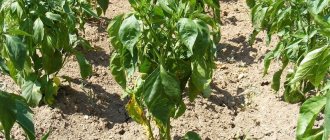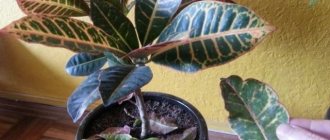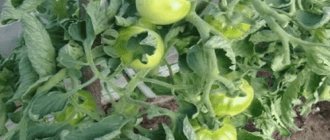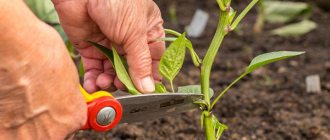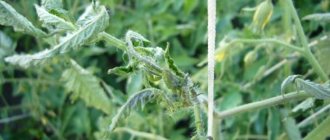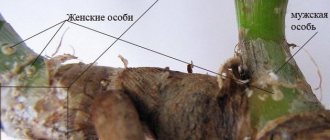We watered and fed the pepper, as every year, but it suddenly became “sad” and “hung” its leaves? Most often, he can be helped quickly enough, the main thing is to establish the cause in time.
Peppers are not such a frequent visitor to our greenhouses as tomatoes and cucumbers. However, it is not difficult to care for, and it is less susceptible to disease than other nightshades. If you don’t forget about watering, loosening and mulching the soil, pinching and pinching, fertilizing and treating against infections, the harvest will not be long in coming. But sometimes it happens that even if all the rules are followed, the leaves on the pepper bushes look wilted in the summer. What could have provoked such a turn of events?
Why pepper leaves wither in a greenhouse: reasons
The wilting of peppers cannot appear suddenly; it occurs as a result of violation of certain conditions and growing technology.
These include:
- stress after changing the growing environment;
- deviations from the norm of the greenhouse microclimate;
- inadequate soil;
- violation of irrigation conditions;
- influence of pests and diseases;
- the formation of the bush occurs in violation of the timing or technology of the process;
- There is no tying of the crown of tall varieties.
Important! The plant may also wither due to the aging of the bush.
As a rule, the wilting process occurs as follows: drops of water fall on the leaves of the pepper bush and, under the influence of sunlight refracted in a greenhouse, become very hot. Under the influence of high temperatures, the leaf area dries out greatly.
If the cause of wilting lies in insufficient aeration of the rhizome of the bush, then this is due to the fact that the soil is not loose enough and a crust appears on the surface of the soil, which blocks air access to the roots. Insufficient respiration of the root system is also the reason that the leaves dry out and wither.
Stress after transplant
Pepper seedlings are transferred to greenhouse soil when each young bush has 12–14 leaves. The stem of a healthy plant during this period should reach almost 25 cm. Transplantation occurs in mid-May, when the soil has warmed up sufficiently. If you do this earlier, the bush may begin to wilt. In addition, changes in soil and growing conditions can stress the plant and it may begin to wither.
Did you know? Pepper, which in our country is usually called Bulgarian, does not come from this sunny country at all, but from America, from where
ancient sailors brought it first to Portugal, then information about it appeared in Turkey, and then it came to Bulgaria itself, where This vegetable is simply called bell pepper or paprika.
Disturbance of the microclimate in the greenhouse
It is very important to create and control the correct microclimate in greenhouse conditions.
This applies to indicators such as:
- temperature. High rates can have a detrimental effect on the plant, and first of all this will be manifested by wilting. There should be no sudden changes;
- humidity. High humidity does not give the plant the opportunity to develop well; the optimal level is in the range of 60–65%, and when it comes to seedlings - 75%;
- ventilation. Mandatory ventilation of the greenhouse must be carried out to remove excess moisture and reduce the temperature in the enclosed space.
Unsuitable soil composition
Peppers can be planted in soil in which carrots, dill or onions previously grew - this will have a beneficial effect on the quality of the soil. If the soil was taken or purchased from the place where eggplants, potatoes or tomatoes previously grew, it contains weeds and spores of various fungal diseases - all this can cause the peppers in the greenhouse to wither.
Bell pepper reacts very sensitively to an excess of fertilizers, which can manifest itself in the form of wilting or lack of ovary on the bushes. You should also control acidity, because a violation of this parameter can be another reason for the deterioration of the appearance of the leaves.
Important! To improve air exchange and respiration of the root system, it is extremely important to loosen the soil; mulching the soil also contributes to this.
Improper watering
If the peppers have wilted in the greenhouse, the reason may lie in the abundant watering of the bushes. Too wet soil can become a breeding ground for fungal diseases and also cause root rot. An imbalance in water balance can also cause sweet peppers to weaken and wither. It is recommended to water in the morning and evening, but so that by nightfall the leaves of the bushes are already dry.
Diseases and pests
A change in the condition of the leaves may be one of the symptoms of diseases such as:
- fusarium wilt;
- verticillium wilt;
- white spotting;
- white rot.
Infestation by pests that carry diseases or harm the plant as a result of their vital activity can cause peppers to die in a greenhouse.
Did you know? Bell peppers, or sweet peppers, have a lot in common with chocolate. The similarity is that these products cause an increase in mood and a surge of energy due to the action of endorphins
-
“happiness hormones” in the blood.
It can be:
- whiteflies;
- garden scoops;
- slugs;
- mites;
- aphid;
- ants.
Preventative work
Preventive measures help prevent pepper seedlings from falling. To avoid problems, you must follow the following recommendations:
- Disinfect seeds before sowing. To do this, they need to be wrapped in gauze and immersed in a solution of potassium permanganate or growth stimulants for several hours.
- Infections that provoke bending of shoots develop in soil with a high level of acidity. To lower the pH, add wood ash to the soil. In addition, it has antibacterial properties.
- Water the pepper only with warm, settled water. It is desirable that it be melted or rain.
- To prevent crust formation, the soil must be loosened periodically.
- After any gardening work, sterilize all tools.
To avoid contracting infections, follow these safety precautions:
- for cultivation, purchase varieties that are resistant to diseases (Lastochka, Agapovsky, Elephant, Hercules, Orange Miracle and others);
- store seed in a dry, ventilated area;
- before planting, disinfect the land and seeds; • inspect the plants daily for timely detection of diseases, and if they are detected, begin immediate control using available methods;
- observe the interval between bushes to prevent thickening;
- do not overwater the plants.
To summarize, we can conclude that the decline of pepper seedlings is due to errors in maintenance and care. Even fusarium, verticillium and blackleg, which provoke bending of the stems and drying out of the plant, develop for the same reasons.
To get a rich and healthy harvest that does not have to be ripened, you must follow the simple rules and recommendations listed above.
What to do and how to fix the problem
In order to stop the wilting of peppers, you need to do the following:
- First of all, it is necessary to find out the reason for the change in the appearance of leaves.
- Ensure normalization of the microclimate in the greenhouse, keep temperature and humidity levels under control, and carry out regular ventilation.
- Control the quantity and quality of fertilizers applied at the root and in the trench next to the bush. They must be balanced, comprehensive and in the required volume.
- Weed the beds, ensuring air flow to the roots, which will ensure the full functioning of the plant.
- Spray the bush against pests. To find out what to spray the pepper with, you need to carefully examine the bush and note on it additional signs of certain diseases or pests, for the destruction of which it is necessary to use specific means.
You will be interested to know about such varieties of sweet pepper as: Golden Miracle, Gipsy, Winnie the Pooh, Tusk, White Gold, Kubyshka and Poljot.
What causes verticillium wilt?
This disease is caused by special fungi that live in the soil and have great viability (up to 15 years).
They enter the plant through wounds. Once in the conducting paths, the pathogens of verticillium wilt clog them, and the plant dies (partially or completely). But even if it does not die completely, the peppers will grow small and withered.
Affected plants should be removed.
Most often, infection occurs in the hot months of summer at a temperature of 25 ° C and dry soil.
Prevention measures
In order to prevent the plant from becoming extremely difficult, when its leaves have wilted and are ready to fall off, a number of preventive measures should be carried out, which involve the following actions:
- Regularly inspect the bushes for damage and changes in the appearance of leaves, stems and fruits. It is also necessary to monitor the condition of the soil and the general microclimate in the greenhouse.
- Peppers should not be grown in the same area of the garden for several years in a row. The planting can be returned to its original location after 4 years.
- It is necessary to completely destroy weeds and tops residues after harvesting - for this they are burned.
- Preventive loosening of the soil should be carried out regularly.
- The soil must undergo a mandatory disinfection procedure.
- At the stage of planning the purchase of seeds, it is necessary to study data on what diseases the pepper variety that you plan to grow is susceptible to.
- To increase vitality and resistance to diseases, it is possible to preventively spray the bushes with Zircon, Epin, and Novosil.
Timely prevention and control over the process of growth and development of sweet pepper bushes in a greenhouse will help avoid leaf wilting and will contribute to growing a good harvest.
Nutrient deficiency
If it's not too hot outside and the leaves still look a little wilted, your plants may be lacking nutrients. Remember when and what you last fed the crop with and fill in the gap.
Before fruiting begins (at the very end of flowering or at the stage of the appearance of ovaries), peppers need to be fed. To do this, 10 g of ammonium nitrate, 25 g of superphosphate and 25 g of potassium sulfate are diluted in 10 liters of water. Instead, you can use complex fertilizers for tomatoes and peppers according to the instructions.
Three to four weeks after this, the fertilizing is repeated, removing saltpeter from the composition. In the first half of summer, you can replace mineral fertilizers with a solution of bird droppings (1:20), manure (1:10) or herbal infusion (1:5), and in the second half, use ash infusion (2 cups of ash per 10 liters of water).
Root feeding of the crop must be combined with watering to avoid burns to the root system of the bush.
Causes of leaf deformation
Many gardeners are familiar with the phenomenon of deformation and. This is caused by the uneven development of the veins compared to the leaf tissue. No action required. Development will level out as the seedling grows.
It is much worse when the leaves curl, become pale green, and during further growth they dry out and fall off. Pepper seedlings disappear. This may be caused by a lack of potassium
.
Feeding the seedlings with wood ash or potassium nitrate, which is diluted at the rate of 35-40 grams per bucket of water, will help.
Why do pepper seedlings lose leaves? Leaf curling and drying out may occur due to damage
. Most often this occurs as a result of an attack. The leaves curl, dry, wither and fall off. When examining the affected leaves, it is clearly noticeable that they are entwined with cobwebs. Leaves are chewed and dry. All the juices have been sucked out of them.
The best option is to manually collect the affected leaves, followed by spraying the seedlings with Fitoverm.
Why pepper leaves curl and wither, how to deal with crop withering
Deformed leaves that have lost color and strength on pepper seedlings are a clear sign of gross agrotechnical errors in the cultivation process. Greenhouse plants, due to climatic conditions, can forgive many mistakes, but such a reaction indicates the need for immediate intervention.
First of all, remove all diseased leaves and fruitless shoots. And also keep an eye on: The humidity level in the room
.
Use a mechanical hygrometer or electronic moisture meter for this. In a greenhouse, each crop requires its own water level. For peppers, the best option is the same humidity as for cucumbers - at 60-65%. Moreover, at the seedling stage, this indicator should start at 75%. Temperature in the greenhouse
.
With a sharp imbalance in temperature and humidity, plant growth begins to fail. To help deformed crops develop properly, avoid sudden changes. Please note that when the temperature rises by 5°, the humidity level drops by 20 marks. Daily ventilation
.
There is no need to spare the seedlings, protecting them from fresh air. On the contrary, it will promote biochemical processes inside the fibers, as a result of which the root system and bush will be strengthened. In hot weather, ventilation will solve the problem of increased temperature, and in cold weather, open the windows in the greenhouse only for a short time during the day. Number of waterings
.
The more water, the juicier the fruits will be. The periods of necessary irrigation can be determined by eye based on the condition of the stem and soil. Do not forget that excess moisture is a favorable environment for the development of fungal spores, and its deficiency dries out the pollen. It is better to water the plants in the morning. State of the stem in the evening
.
All chemical sprinkling, watering, sprinkling and fertilizers must be carried out in such a way that the bushes are dry by evening. Top layer of soil
.
There should be no dried, tight crust or weeds on it. Regularly loosen the soil, which helps aerate the pepper roots. Do not forget about preventive treatments
of seedlings against harmful insects and pathogens.
Useful tips
You can provide peppers with a favorable environment for development and fruiting by following the advice of experienced gardeners:
- Be careful about the quality of your seeds. If you are not sure about them, before sowing, for disinfection, first soak for 20 minutes in potassium permanganate, and then, after thoroughly rinsing with water, for 12 hours in the Zircon preparation.
- Don't plant seedlings too early. The optimal time is between mid-March and early April. In this case, you will spend much less time keeping the plant in a stuffy room.
- Remove plant parts remaining in the soil after harvesting. Some of them can leave behind pathogenic fungi, bacteria and viruses that are not afraid of winter. Crop rotation may not be enough - the only effective solution is to burn all plant residues.
Features of the treatment of sweet bell pepper
There are several reasons why bell pepper leaves curl:
- In some cases, leaves curl if the central vein grows faster than the entire leaf blade. The leaf then takes on an irregular shape. This is due to lack of light. The defect goes away when the light in the greenhouse is adjusted.
- The leaves curl upward in a boat when there is a lack of water. This plant reduces the area of moisture evaporation. Timely watering eliminates this cause.
- If, when curling, the leaves are still covered with dark spots and dots, this indicates a viral mosaic infection. The culture is treated with a pink solution of potassium permanganate.
- With a lack of potassium, the leaves curl inward. Fertilizing with wood ash helps with this: 3 tbsp. l. pour under each bush and water the soil. Add potassium nitrate at the rate of 10 g of the drug per 5 liters of water.
Acute
When growing hot peppers, it is necessary to constantly moisten the soil and maintain the temperature at the same level. Its leaves are thin, elongated, require a lot of moisture, and when there is drought, they droop and fall off. Hot peppers require a lot of light when growing; if there is not enough light, the ovary dies.

